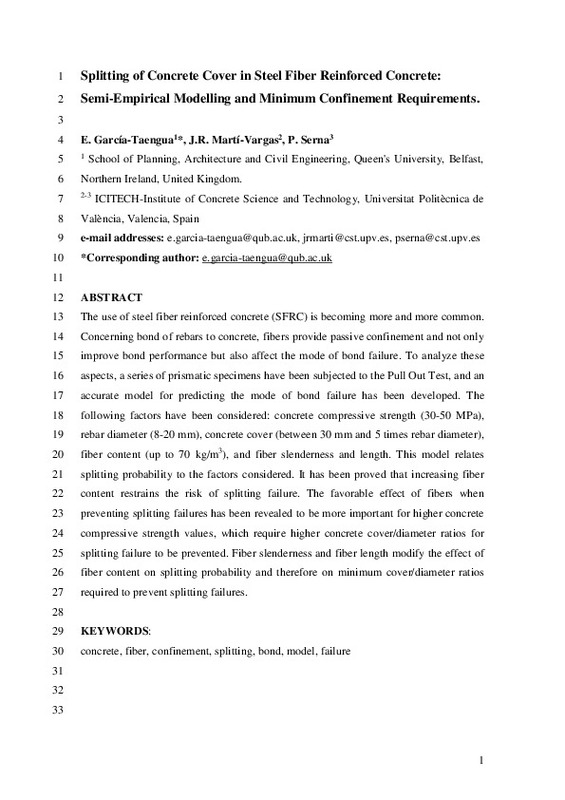JavaScript is disabled for your browser. Some features of this site may not work without it.
Buscar en RiuNet
Listar
Mi cuenta
Estadísticas
Ayuda RiuNet
Admin. UPV
Splitting of concrete cover in steel fiber reinforced concrete: Semi-empirical modeling and minimum confinement requirements
Mostrar el registro sencillo del ítem
Ficheros en el ítem
| dc.contributor.author | García Taengua, Emilio José
|
es_ES |
| dc.contributor.author | Martí Vargas, José Rocío
|
es_ES |
| dc.contributor.author | Serna Ros, Pedro
|
es_ES |
| dc.date.accessioned | 2015-06-16T11:14:53Z | |
| dc.date.available | 2015-06-16T11:14:53Z | |
| dc.date.issued | 2014-09 | |
| dc.identifier.issn | 0950-0618 | |
| dc.identifier.uri | http://hdl.handle.net/10251/51778 | |
| dc.description.abstract | The use of steel fiber reinforced concrete (SFRC) is becoming more and more common. Concerning bond of rebars to concrete, fibers provide passive confinement and not only improve bond performance but also affect the mode of bond failure. To analyze these aspects, a series of prismatic specimens have been subjected to the Pull Out Test, and an accurate model for predicting the mode of bond failure has been developed. The following factors have been considered: concrete compressive strength (30 50 MPa), rebar diameter (8 20 mm), concrete cover (between 30 mm and 5 times rebar diameter), fiber content (up to 70 kg/m3), and fiber slenderness and length. This model relates splitting probability to the factors considered. It has been proved that increasing fiber content restrains the risk of splitting failure. The favorable effect of fibers when preventing splitting failures has been revealed to be more important for higher concrete compressive strength values, which require higher concrete cover/diameter ratios for splitting failure to be prevented. Fiber slenderness and fiber length modify the effect of fiber content on splitting probability and therefore on minimum cover/diameter ratios required to prevent splitting failures. | es_ES |
| dc.description.sponsorship | The authors of this work wish to thank both the Research Bureau of the Spanish Ministry of Science and Innovation and the 'Plan E' programme for the funding of the project 'BIA 2009-12722', this research being a part thereof. | en_EN |
| dc.language | Inglés | es_ES |
| dc.publisher | Elsevier | es_ES |
| dc.relation.ispartof | Construction and Building Materials | es_ES |
| dc.rights | Reconocimiento - No comercial - Sin obra derivada (by-nc-nd) | es_ES |
| dc.subject | Concrete | es_ES |
| dc.subject | Fiber | es_ES |
| dc.subject | Confinement | es_ES |
| dc.subject | Splitting | es_ES |
| dc.subject | Bond | es_ES |
| dc.subject | Model | es_ES |
| dc.subject | Failure | es_ES |
| dc.subject.classification | INGENIERIA DE LA CONSTRUCCION | es_ES |
| dc.title | Splitting of concrete cover in steel fiber reinforced concrete: Semi-empirical modeling and minimum confinement requirements | es_ES |
| dc.type | Artículo | es_ES |
| dc.identifier.doi | 10.1016/j.conbuildmat.2014.06.020 | |
| dc.relation.projectID | info:eu-repo/grantAgreement/MICINN//BIA2009-12722/ES/EL HORMIGON DE FIBRAS DE ACERO COMO SUPERACION DEL HORMIGON TRADICIONAL Y SUS PERSPECTIVAS DE FUTURO/ | es_ES |
| dc.rights.accessRights | Abierto | es_ES |
| dc.contributor.affiliation | Universitat Politècnica de València. Departamento de Ingeniería de la Construcción y de Proyectos de Ingeniería Civil - Departament d'Enginyeria de la Construcció i de Projectes d'Enginyeria Civil | es_ES |
| dc.description.bibliographicCitation | García Taengua, EJ.; Martí Vargas, JR.; Serna Ros, P. (2014). Splitting of concrete cover in steel fiber reinforced concrete: Semi-empirical modeling and minimum confinement requirements. Construction and Building Materials. 66:743-751. https://doi.org/10.1016/j.conbuildmat.2014.06.020 | es_ES |
| dc.description.accrualMethod | S | es_ES |
| dc.relation.publisherversion | http://dx.doi.org/10.1016/j.conbuildmat.2014.06.020 | es_ES |
| dc.description.upvformatpinicio | 743 | es_ES |
| dc.description.upvformatpfin | 751 | es_ES |
| dc.type.version | info:eu-repo/semantics/publishedVersion | es_ES |
| dc.description.volume | 66 | es_ES |
| dc.relation.senia | 285258 | |
| dc.contributor.funder | Ministerio de Ciencia e Innovación | es_ES |






![[Cerrado]](/themes/UPV/images/candado.png)


